oneworld's BA and Qantas may shake up global alliances irreversibly as Emirates and Qatar enter
The lucrative yet delicate world of airline partnerships and alliances is set to receive the largest shakeup in recent years with the oneworld alliance actively exploring what its base would like with the addition of a Middle East network carrier - most likely to be Qatar Airways or, possibly, Etihad Airways. The addition of either would shift a mere 1% of the world's total air capacity, but the implications would be far-reaching.
The more likely outcome, however, is that British Airways and Iberia will partner with Qatar Airways while Qantas partners with Emirates. The remaining oneworld carriers will work out their position amidst the overlap. oneworld has never been a tight federation and British Airways and Qantas have their respective reasons to choose alternative paths. Already airberlin has aligned itself with Etihad, which could make oneworld the friendliest group to Middle East network carriers.
- The oneworld alliance is considering adding a Middle East network carrier, most likely Qatar Airways or Etihad Airways, which would have far-reaching implications.
- British Airways and Iberia are likely to partner with Qatar Airways, while Qantas is expected to partner with Emirates.
- The addition of Qatar Airways or Etihad Airways to oneworld would shift a mere 1% of the world's total air capacity.
- Qatar Airways would be the most effective partner for oneworld, as Emirates has become too large to easily integrate into an alliance.
- The relationship between International Airlines Group (IAG) CEO Willie Walsh and Qatar Airways CEO Akbar Al Baker could be pivotal in the decision-making process.
- The addition of Qatar Airways or Etihad Airways to oneworld would provide the alliance with strength in emerging markets in Africa and Asia, as well as in the Middle East.
The courting is most apparent from International Airlines Group (IAG) CEO Willie Walsh, who has spoken highly of Qatar Airways and its always engaging CEO Akbar Al Baker. Mr Walsh, representing IAG's British Airways and Iberia, will bring a significant change of strategy to legacy carriers that have largely shunned Middle East rivals. But the world has changed and the major alliances recognise the upside competitors can bring as partners - and the downside if their competitors move first. The latter is increasingly becoming a motivator.
Mr Walsh's strong support of Middle East network carriers dates back to at least Jun-2010, when he proclaimed to Business Travel News, "Many of my European counterparts will bitch and moan about the way the Middle East carriers operate; they think that it is unfair competition. I don't buy into that." He also laid the groundwork for his view that three independent hubs in the Middle East were too many. "Whether you can establish three hubs in such a small area is going to be a challenge, and I may well agree with that part - that there isn't room for three in the Middle East."
This year Mr Walsh predicted a Middle East network carrier would join a global alliance, with the suggestion being the membership would be at his hosting. "I will be amazed if one of the Gulf carriers does not join an alliance this year. It would be a healthy development. We have certainly discussed Gulf airline membership in oneworld at great length," Mr Walsh told CAPA in Apr-2012. The addition of Etihad to oneworld would boost its share of the world's available seats from 12.1% to 12.5% while Qatar would boost the figure to 12.7%.
Alignment of global capacity (seats) based on active and announced alliance members, and with added capacity from Etihad or Qatar: 04-Jun-2012 to 10-Jun-2012
| Current global capacity | - |
|---|---|
 |
- |
| Current global capacity with Etihad joining oneworld | Current global capacity with Qatar joining oneworld |
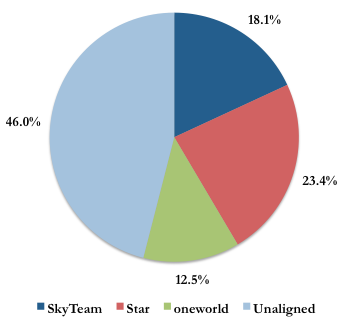 |
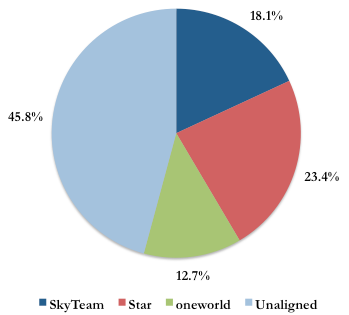 |
Qatar Airways would be the most effective partner for oneworld
Of the three theoretical candidates - Emirates, Etihad and Qatar - Qatar would be the most effective for oneworld. Emirates has become sufficiently large that it can not only sustain itself on its own without worry but that same size would make it potentially difficult to integrate into an alliance. The exception is in Australia, where embattled Qantas needs a larger partner, and Emirates fits the bill.
Etihad's strategy is to be selective in its bilateral partnerships
Etihad meanwhile is the smallest of the three Gulf carriers, a situation unlikely to change given its has approximately 90 aircraft on order compared to Qatar's 190. Etihad has formed an extensive network of codeshares, interlines and cross-equity (the largest of any of the Middle East three) that would fall under serious revision if it were to join oneworld. Its partnerships are strategic and span aligned and unaligned carriers where geographically convenient. Sacrificing beneficial partnerships for a lesser carrier affiliated with oneworld, or because it would not be permitted to partner with a SkyTeam or Star Alliance carrier, further makes it unlikely to join a global alliance. Its interest in partnering with SkyTeam's Air France-KLM, as well as a recent 5% equity stake in Virgin Australia (competitor to oneworld's Qantas) further suggests it will continue to chart a non-aligned yet strong path.
See related articles:
- Air France-KLM to partner with Etihad? - If you can't beat them, join them
- Middle East network carriers strategies vary on partnerships but both seem to work
- Etihad moves on Air Berlin and the world's aviation axis shifts. What will Willie do next?
The Walsh-Al Baker relationship could be pivotal
As for interest from other alliances, SkyTeam could show potential but Star is highly unlikely, given anchor member Lufthansa's (apparent) fervent dislike of the Middle East network carriers. Additionally, member Turkish Airlines has the same strategy as those three and with nearly similar geography to its benefit; Star thus effectively already has a global network carrier in the region.
But it is the relationship between Mr Walsh and Mr Al Baker that could prove pivotal. Mr Al Baker will certainly like it that oneworld, although the smallest of the three, prides itself on connecting what it argues are the world's largest business markets, and therefore high-yielding.
The benefit Qatar - or Etihad - would bring to IAG is not simply strength in new numbers. When oneworld's most recent member, airberlin, joined in Mar-2012, oneworld noted how much the carrier extended the alliance's network, especially in the large German domestic market. Qatar by contrast would add a mere 17 destinations to oneworld's network of what it says is over 800. These supplementary destinations are primarily in emerging, but not first tier, markets. Six of the 17 destinations would likely have been added to oneworld's network if its plan for India's Kingfisher Airlines to join the alliance earlier this year had persevered; now Kingfisher's fate, let alone alliance allegiance, is uncertain.
See related article: airberlin joins oneworld alliance, but its full potential will not be immediately realised
There are only two destinations Qatar would not add that Etihad would: Astana and Kabul. Etihad, however, would bring far fewer new destinations to oneworld's network, at only 10. With the exception of India's Trivandrum, all of the new destinations Etihad or Qatar would bring to oneworld are already served by SkyTeam, Star or both. (Trivandrum is served by SilkAir, wholly owned by Singapore Airlines but not included in the alliance, although parent SIA codeshares on SilkAir's Trivandrum service.) In a testament to Star's strength following the addition of Turkish Airlines, many destinations that Etihad or Qatar would bring to oneworld are served by Turkish, underscoring the benefits oneworld could derive from a global network carrier.
The opportunity, therefore, for oneworld is not size but efficiency by way of having better connections. For example, while oneworld may already claim Entebbe and Hyderabad as destinations, via service from only British Airways, the need to connect through London to access those destinations make them of little benefit to Japan Airlines (JAL) or Qantas.
New passenger destinations, served or planned, Etihad or Qatar would bring to oneworld: 06-Jun-2012
| Etihad destinations new to oneworld | Qatar destinations new to oneworld | Service by other alliances |
|---|---|---|
| n/a | Ahmedabad, India | Star |
| n/a | Ankara, Turkey | SkyTeam, Star |
| Astana, Kazakhstan | n/a | SkyTeam, Star |
| Calicut, India | Calicut, India | SkyTeam |
| Cochin, India | Cochin, India | SkyTeam |
| n/a | Goa, India | SkyTeam |
| Islamabad, Pakistan | Islamabad, Pakistan | SkyTeam, Star |
| Kabul, Afghanistan | n/a | Star |
| n/a | Kigali, Rwanda | SkyTeam, Star |
| n/a | Kilimanjaro, Tanzania | SkyTeam, Star |
| n/a | Kolkata, India | SkyTeam, Star |
| Lahore, Pakistan | Lahore, Pakistan | SkyTeam, Star |
| Mahe, Seychelles | Mahe, Seychelles | SkyTeam, Star |
| n/a | Mashhad, Iran | SkyTeam, Star |
| Peshawar, Pakistan | Peshawar, Pakistan | SkyTeam |
| n/a | Shiraz, Iran | Star |
| Tehran, Iran | Tehran, Iran | SkyTeam, Star |
| Trivandrum, India | Trivandrum, India | n/a |
| n/a | Yangon, Myanmar | SkyTeam, Star |
Etihad Airways and Qatar Airways network summary: 10-Jun-2012
| Etihad | Qatar | |
|---|---|---|
| Total non-stop active passenger destinations | 72 | 109 |
| Domestic | 1 | 1 |
| Africa | 7 | 17 |
| Asia Pacific | 32 | 38 |
| Europe | 15 | 30 |
| Latin America | 0 | 2 |
| Middle East | 14 | 17 |
| North America | 3 | 4 |
The addition of Etihad or Qatar to oneworld would shift 1% of world's capacity
Measuring the distribution of available seat kilometres shows the addition of Etihad or Qatar to oneworld would shift, respectively, 0.9% or 1.2% of global capacity based on current market levels, according to CAPA's Alliance Predictor Tool. As with available seats, Qatar would represent a slightly bigger gain for oneworld than would Etihad.
Alignment of global capacity (ASKs) based on active and announced alliance members, and with added capacity from Etihad or Qatar: 04-Jun-2012 to 10-Jun-2012
| Current global capacity | - |
|---|---|
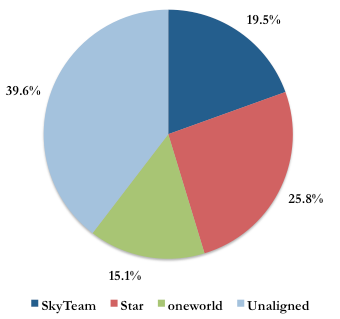 |
- |
| Current global capacity with Etihad joining oneworld | Current global capacity with Qatar joining oneworld |
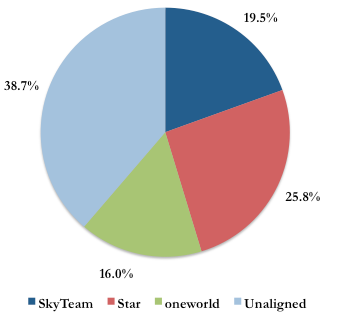 |
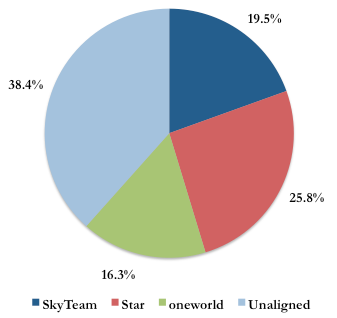 |
oneworld's gain of a Middle East network will be felt most, from a capacity perspective, in the new member's home market of the Middle East. oneworld's share of traffic (ASKs) in the Middle East could nearly triple to 16.4%, placing it ahead of SkyTeam, which benefits from new member Saudia and member-elect Middle East Airlines (MEA).
See related article: Saudi Arabian Airlines, now known as Saudia, joins SkyTeam and adds 35 destinations
Alignment of Middle East capacity (ASKs) based on active and announced alliance members, and with added capacity from Etihad or Qatar: 04-Jun-2012 to 10-Jun-2012
| Current Middle East capacity | - |
|---|---|
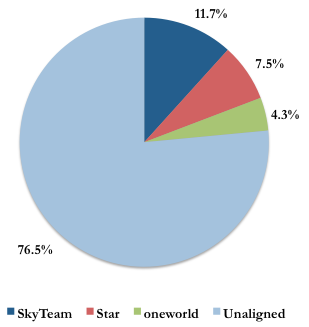 |
- |
| Current Middle East capacity with Etihad joining oneworld | Current Middle East capacity with Qatar joining oneworld |
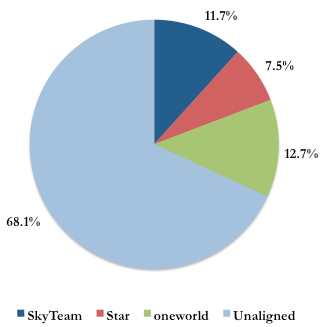 |
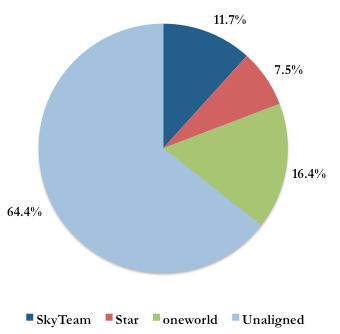 |
Etihad or Qatar would provide oneworld strength in emerging markets of Africa and Asia
Mr Walsh highlighted during the bmi acquisition that Africa and Asia are particular areas he would like to grow his airlines, British Airways and Iberia. Either Etihad or Qatar would provide significant lift in those markets. Mr Walsh may not see his group carriers fully recognise Qatar's strength as one-stops through Doha can be circuitous, especially to certain parts of Africa. But there is no doubt the additions will be welcomed by BA and Iberia, as well as oneworld, which has no presence in Africa, unlike SkyTeam with Kenya Airways and Star with Egypt, Ethiopian and South African.
See related article: British Airways plans two phases to bring bmi, and its London Heathrow slots, to profitability
Alignment of Africa capacity (ASKs) based on active and announced alliance members, and with added capacity from Etihad or Qatar: 04-Jun-2012 to 10-Jun-2012
| Current Africa capacity | - |
|---|---|
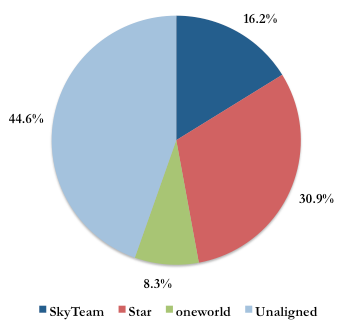 |
- |
| Current Africa capacity with Etihad joining oneworld | Current Africa capacity with Qatar joining oneworld |
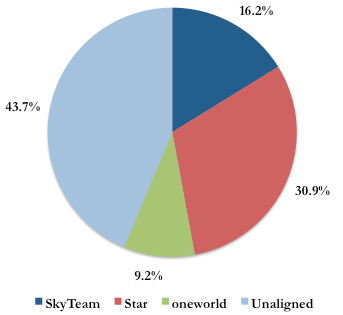 |
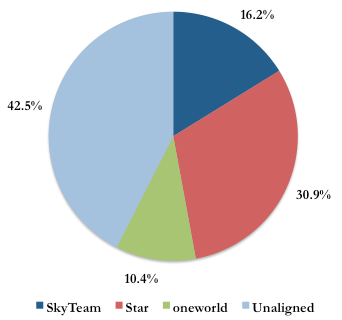 |
oneworld is also the weakest of the global alliances in the Asia Pacific region, a situation aggravated by dominant carrier Cathay Pacific taking an ambivalent stand and working with few members, partially a result of it competing with British Airways to its key market of London and greater Europe, with Japan Airlines on a host of routes and Qantas to Australia (where competition laws prevent partnering).
Looming is Cathay's cross-equity with Star's Air China and musings from Beijing that Air China and Cathay should grow closer, which could see Cathay leave oneworld for Star. Such a scenario could pave the way for the addition of Hainan Airlines Group, which includes Hainan in the mainland and Hong Kong Airlines in the namesake special administrative region.
Cathay has argued it can sufficiently serve the mainland for oneworld and would not welcome a mainland Chinese carrier, such as Hainan - the sole remaining large unaligned carrier in mainland China - let alone Hainan's sister in Cathay's hometown. While Hainan Group in the medium term would supply oneworld with less capacity than Cathay, access to the domestic mainland market could potentially outweigh the loss of Cathay.
Alignment of Asia Pacific capacity (ASKs) based on active and announced alliance members, and with added capacity from Etihad or Qatar: 04-Jun-2012 to 10-Jun-2012
| Current Asia Pacific capacity | - |
|---|---|
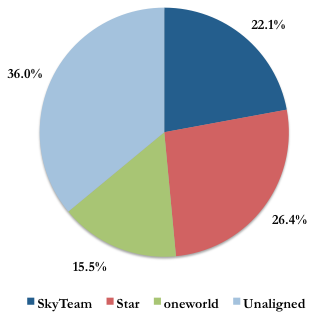 |
- |
| Current Asia Pacific capacity with Etihad joining oneworld | Current Asia Pacific capacity with Qatar joining oneworld |
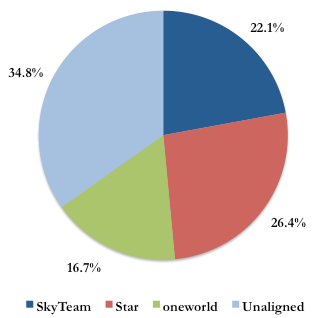 |
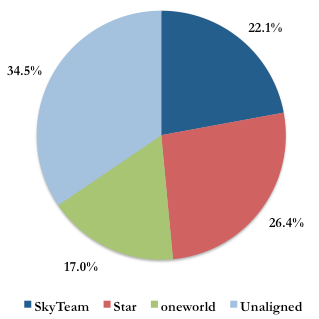 |
oneworld would also benefit in India from Etihad or Qatar as Jet Airways looks likely to join Star
In India, oneworld is stronger than SkyTeam but weaker than Star, a testament to the significant capacity from each alliance's anchor European members; British Airways has more capacity than Air France-KLM but less than the Lufthansa Group.
The divide will grow further as India this year is increasingly likely to allow Jet Airways to join Star Alliance.
See related article: CAPA India International Outlook 2012/13: Some surprises ahead, Jet could join Star, A380 may debut
Given the large size of the Indian domestic market, and with no local carriers part of a global alliance yet, oneworld's presence of total seats in, out and within India will still remain small even with the addition of Etihad or Qatar.
Alignment of India system capacity (seats) based on active and announced alliance members, and with added capacity from Etihad or Qatar: 04-Jun-2012 to 10-Jun-2012
| Current India system capacity | - |
|---|---|
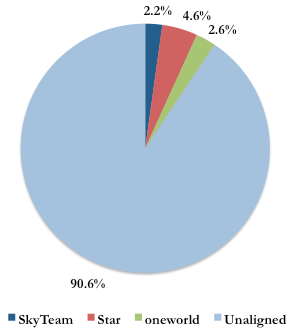 |
- |
| Current India system capacity with Etihad joining oneworld | Current India system capacity with Qatar joining oneworld |
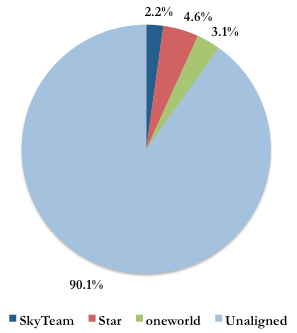 |
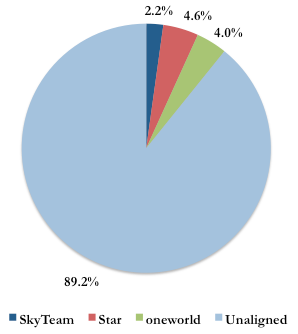 |
Looking only at India's international seats (thus excluding its large domestic market), the addition of Etihad or Qatar in oneworld will have a more pronounced effect for the alliance.
Alignment of India international capacity (seats) based on active and announced alliance members, and with added capacity from Etihad or Qatar: 04-Jun-2012 to 10-Jun-2012
| Current India international capacity | - |
|---|---|
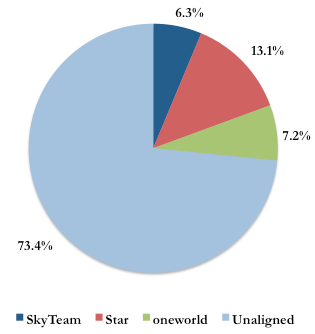 |
- |
| Current India international capacity with Etihad joining oneworld | Current India international capacity with Qatar joining oneworld |
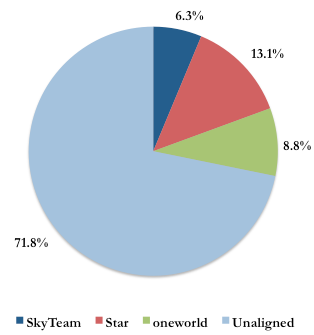 |
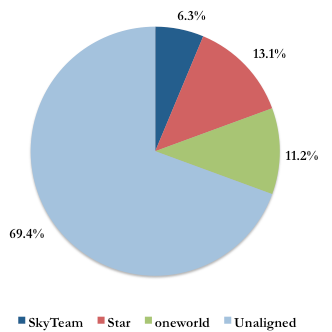 |
For oneworld's existing members, Etihad or Qatar would bring opportunities but also challenges - and global upheaval
Etihad's, or more likely Qatar's, entry into oneworld would likely be sponsored by British Airways, but the alliance's dichotomy makes it more likely members will choose individual paths. Many remaining members could be expected to welcome Qatar. Integrating Qatar would provide opportunities but also challenges.
airberlin
airberlin would be most conflicted as Qatar's competitor Etihad owns nearly 30% of airberlin and the two have undertaken significant planning, ranging from networks to procurement. airberlin may simply take a hands-off approach with Qatar, although under alliance rules it would typically be required to have reciprocal frequent flyer access with Qatar.
Such a situation may be passed off as a reality of the convoluted webs airlines find themselves in as a result of individual alliance decisions. airberlin, after joining the oneworld alliance, bluntly stated this reality of conflicted interests when, in relation to if a oneworld carrier would prefer airberlin to partner with it instead of Etihad, CEO Hartmut Mehdorn remarked "Of course," but underwhelmed by the lack of oneworld carriers launching flights to its hub at Berlin, added, "and we would prefer a flight to Berlin. It's a give and it's a take."
See related article: airberlin makes no apologies for Etihad alliance after joining oneworld
airberlin's position would change little if Qatar did not join oneworld but made individual partnerships, such as with British Airways and Iberia. A far bigger headache for airberlin would be overlap if Air France-KLM finalises a partnership with Etihad, under which Air France-KLM may try, in earnest or as a negotiating tactic, to gain access to airberlin's network.
Cathay Pacific, Malaysia Airlines, JAL and LAN
Cathay Pacific can be expected to continue its hands-off approach if Qatar or Etihad entered the mainframe, although it may find opportunistic Qatar's Middle East and African networks. China-Africa traffic is set to grow rapidly, albeit from a low base, and Cathay's sole service is to Johannesburg, offering few connecting opportunities. Etihad, meanwhile, does not serve Hong Kong.
Member elect Malaysia Airlines (MAS), due to join oneworld at the end of the year, has trimmed its Middle East network as part of its restructure but faces stiff competition from Emirates' large deployment of capacity to Kuala Lumpur. (Doha-Kuala Lumpur is Qatar's eighth largest route by ASKs.) MAS may also find it beneficial to work with Qatar and its Doha hub to restore links to its cut cities of Dammam, Dubai and Karachi.
See related article: MAS will achieve its targeted 12% capacity reduction by February, to the delight of Gulf carriers
Meanwhile JAL, despite a limited partnership with Emirates, has expressed interest in having greater connectivity to the Middle East, although prior to Qatar's likely inclusion in oneworld, JAL was not considering flying to Doha. The Japan-Qatar bilateral agreement will be expanded from mid-2013, although access will still not be open skies, potentially giving JAL leverage for better beyond access from Doha if it were to launch services there. Currently only Qatar Airways operates between Japan and Qatar while Emirates and Etihad are the sole occupants on Japan-UAE services; All Nippon Airways (ANA) and JAL do not serve the Middle East. JAL would gain access not only to Middle East but also Africa, where visitor numbers have been growing despite no direct link between Africa and Japan, as well as South America. JAL ended its sole South American service, to Sao Paulo, during its restructure. While JAL codeshares with American Airlines, Qatar and its Doha hub would offer a smoother transit experience - with no visa required, unlike with the US - and JAL arguably would prefer to place passengers on Qatar Airways than American Airlines. JAL's recently-approved joint-venture with British Airways could see it fall under the influence of aligning with British Airways' potential partner Qatar.
See related article: Japan-UAE bilateral agreement expands access, welcoming Gulf carriers to serve national interests
Conversely, Chile's LAN may also favour connections between Asia and Latin America through Doha rather than the US. LAN and JAL have begun codesharing on Asia-Latin America services. While LAN is completing a merger with Brazil's TAM, LAN is expected to remain in the oneworld alliance while TAM will either join LAN in oneworld or be an unaligned carrier to reap full benefit of partners interested in the booming Brazilian market, of which it is the most formidable carrier. (Gol is primarily a domestic-only carrier and is cosying up with SkyTeam's Delta.)
Iberia, Finnair and S7
For oneworld's other European members, the potential addition of Qatar could bring limited benefits. Iberia operates what it terms a 90-degree hub, that is all of its long-haul flights head in one direction from Spain: west, to the Americas. Iberia has no flight beyond Tel Aviv. Qatar could potentially like Iberia's vast network to Latin America, a continent that requires high aircraft deployment from Middle East hubs. Iberia also would like to see more profitable connecting traffic rather than loss-making European short-haul feed, even if it tries to correct the situation with Iberia Express.
See related article: Iberia Express launches as Europe's latest salvo to bring short-haul model to profitability
Finnair's current strategy is to link North America and Europe with Asia over its Helsinki hub, which can offer some of the fastest connections. While Qatar Airways is due to to launch a Doha-Helsinki service (making it the first of the Middle East three to serve Finland), Finnair CEO Mika Vehviläinen earlier this year told CAPA he sees little threat from Qatar. "If I look at the flying to Asia, we have so much more direct routes." Finnair's advantage, however, is reaching North Asia, with South and Southeast Asia offering fewer geographic advantages from Helsinki. Here a partnership with Qatar could be possible.
Russia's S7 has been keeping a low international profile, preferring to focus on the strong domestic market as part of its conservative strategy. Qatar could look to codesharing on S7's domestic network. Qatar serves Moscow and St Petersburg.
American Airlines and Royal Jordanian
American Airlines has a notable relationship with Etihad Airways covering US-Abu Dhabi services via direct service and connecting through common European points. American could easily end its Etihad partnership in favour of Qatar. While Qatar had a partnership with United Airlines, earlier this month it was abruptly announced without explanation that the deal would end 15-Jun-2012. While Star's United has been growing its presence in the Middle East and could have seen Qatar more as a competitor than a partner, there have been no major changes in recent strategy and network. American could benefit from Qatar's access to the Middle East as well as India; American earlier this year ended its sole Indian service, to Delhi, as it was unprofitable, largely a result of competition via Europe and the Middle East.
See related article: Non-stop US-India market continues to shrink with American Airlines ending Chicago-Delhi service
A potentially valuable impact of Qatar's addition to oneworld would be on oneworld's existing Middle East member, Royal Jordanian. Royal Jordanian has been following a strategy of serving Jordan and the regional area rather than network traffic like some of its peers. While Royal Jordanian has been growing traffic, regional upheaval and high fuel prices have thwarted profitability. Outgoing CEO Hussein Dabbas told CAPA's Airlines in Transition forum in Apr-2012 that the carrier has benefitted tremendously from its membership in oneworld. The possible addition of Qatar could see Royal Jordanian lose some of those benefits, although these could be offset potentially by providing RJ with a more active complementary role in regional connections.
See related articles:
- As Royal Jordanian grows revenue and passengers but lags in profit, CEO Hussein Dabbas to depart
- Largest loss ever puts damper on Royal Jordanian's continued traffic growth
That leaves Qantas, one of BA's oldest partners - and the odds are on Qantas going with Emirates
Australia's Qantas Group is badly in need of an international and global partner, as evidenced by the forecast for its international division to post an AUD450 million (USD438 million) loss in FY2012. Unfortunately though the reaction among its legacy unions is likely to be at best lukewarm to anything that challenges the status quo, despite the flag carrier's increasingly desperate need for a revitalised international regime. While some elements have championed an Emirates tie-up, whether this is greeted or shunned if it becomes reality is unclear.
This is where the partnership regimes could become very untidy. If IAG concludes a partnership with Qatar, that does not necessarily mean that the entire oneworld tail follows, especially with airberlin already firmly with Etihad. oneworld has always been a fairly loose collection of bilateral agreements between airlines - in contrast with the much more doctrinaire approach of Star.
After all, this is new territory and no-one has written the guide book. Despite Emirates' disavowal of alliance membership, that does not mean of course that partnerships of various types are unwelcome to it, such as with joint FFP agreements. Most recently Emirates is thinly disguising its interest in cementing a place in the Australian market, its third largest international destination. The world's biggest airline (in international ASKs) is likely soon to become a close friend of that country's oneworld airline, Qantas, which controls a very profitable 65% domestic share and crosses the doorsteps of well over half of all Australian homes with its FFP. There is a great synchrony of interest between the two.
See related article: Qantas international loss forecast 'over AUD450m' for FY2012, but domestic now pressured too
While Qantas previously had a partnership with Etihad Airways, it was extremely limited and only covered Etihad's Middle East network, much to the frustration of Etihad CEO James Hogan, who took up the opportunity to form a deeper alliance with Qantas competitor Virgin Australia, leaving Qantas without a Middle East partner. At the time Qantas CEO Alan Joyce was resolute that keeping Etihad at arm's length was appropriate, given the carrier's joint services agreement with British Airways covering Australia-Europe traffic. The chemistry between Mr Hogan and Mr Joyce, each former Ansett employees, was never in the right place, but it would also have meant ructions with BA at that stage.
"Any deeper partnership with Etihad would have been competing against…very important partnerships and very important aspirations," Mr Joyce said in Feb-2011. He described Qantas' joint services agreement with BA as "very successful".
But what a difference a year can make. British Airways and Qantas have cut their Australia-London traffic and while Mr Joyce is confident of some day returning, British Airways is of the view sunken Kangaroo route yields will not provide opportunities for it in the medium term. Not only is there greater Middle East competition, mainland Chinese carriers are also now aggressively targeting Australia; with their lower cost bases they can succeed.
See related article: Chinese airlines' sixth freedom roles could challenge Middle East, Asian, European hubs this decade
The partnership between BA and Qantas is more of the past than it is the future, as evidenced by premium traffic reports from IATA, which have recently shown the largest global decline, at 24%, is in passengers flying between Europe and Australia/New Zealand on the same flight numbers, such as those offered by BA and Qantas, while Middle East-Australia/New Zealand traffic has grown just as steeply (21%).
Also a concern of Mr Joyce's in expanding its former Etihad partnership was Qantas' valuable (bilateral) codeshare with Air France, as well as aspirations from Jetstar to enter Europe.
Yet again the circumstances have changed, removing barriers to a Gulf carrier partnership. Air France's current dallying with Etihad could see it shift away from the Qantas partnership, under which Air France carried passengers between Paris and Singapore, and Qantas between Singapore and Australia. Estimates are that Air France places 100 passengers a day on Qantas' services to Australia.
Another opportunity for Air France is its SkyTeam partner China Southern, which is building an aggressive Australian presence, on which Air France has begun to codeshare - although the Chinese carrier is far from delivering a seamless product transfer to date.
Meanwhile, Jetstar's European ambitions have taken second place to growing its intra-Asia traffic, especially as Asia continues to boom and as Europe remains in the "economic doldrums", as Jetstar CEO Bruce Buchanan has described the situation. In short, the once strong and compelling reasons for Qantas to maintain its old world hub in Southeast Asia are either gone or evaporating.
An intriguing scenario arises, fundamentally rewriting the global alliance guidebook
This sets up an intriguing scenario, in which BA might go ahead with Qatar, while JSA partner Qantas goes in a different direction with Emirates. The ability for Qantas to enhance its global presence enormously by a broad-based codeshare programme with Emirates and the enhancement to Qantas/Emirates' pull in the Australian domestic market takes on stellar proportions. Meanwhile, Qatar, with its much smaller Australian presence, offers nothing like the value to Qantas that it might to British Airways.
During the Etihad discussions, Mr Joyce said Qantas had evaluated flying to Abu Dhabi with a range of aircraft, including the Boeing 777, but decided the service "was not going to be profitable for us". A closer partnership and stronger transfer opportunities, accompanied by extensive codeshares, could sway the economics, be it with Emirates or with Qatar, but especially with Emirates. Australia possesses numerous bilateral rights which Australian airlines are never going to be able to reach with their own metal; Emirates' vast array of destinations could change this, opening up all sorts of opportunities - including one-stop service to dozens of European destinations. Today, as Europe-Australia traffic reroutes rapidly via the Gulf and away from the older Asian routing, that prospect becomes even more alluring, even irresistible.
The ramifications of these respective moves are far-reaching, almost to the extent of a redirection of global aviation strategy. Consequently, they bring with them complexities and contradictions. Yet the time to make bold decisions is when all around is threatening. The nice pieces of this scenario though are that the downsides are limited and, as long as BA and Qantas are prepared to work their way through some untied loose ends, the upside for each carrier is, well, very nice indeed.
There will be some casualties, but even these do not need to be substantial, with a little imagination. The one thing that is sure is that global alliances will never be the same afterwards.